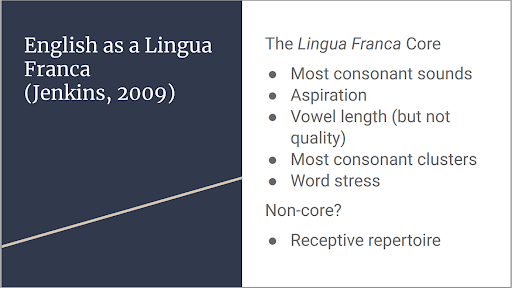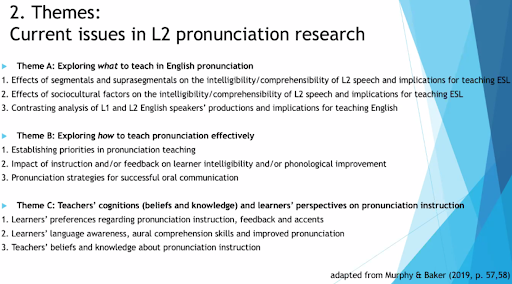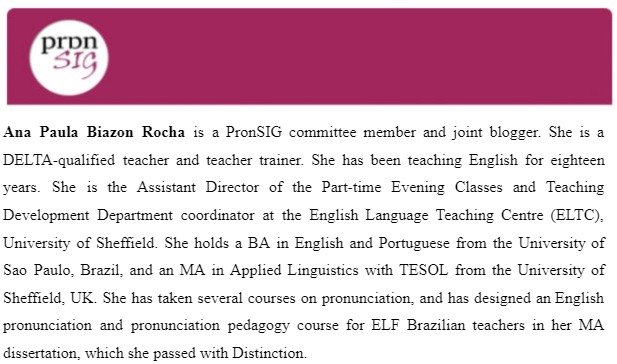By Ana Paula Biazon Rocha
In February and March 2022, PronSIG’s webinars with Victor Medina, Understanding intelligibility in Pronunciation Instruction, and Anastazija Kirkova-Naskova, Research-informed pronunciation instruction: Best practice recommendations, respectively, shed light on the challenges of pronunciation instruction, indicating that the more informed and better prepared teachers are to teach pronunciation, the more benefits there are for learners. However, this is not an easy task and it does not happen overnight. In this post, I invite you to take a moment and reflect on your teaching of pronunciation through analysing some key ideas from both webinars. Are you ready?
Medina and Kirkova-Naskova reinforced core principles in pronunciation instruction, which you may or may not have already heard about, such as intelligibility, the Lingua Franca Core and identifying learners’ needs. They also commented on the importance of bridging the gap between pronunciation research and teachers in the classroom. Let’s check each of these things:
1. Intelligibility should be the main goal of pronunciation instruction, but what is it really?
To answer that, we should consider aspects such as intelligibility, comprehensibility and interpretability:

By the same token, Kirkova-Naskova reminded us of accentedness, or how different a pattern of speech is compared to the local variety (Munro & Derwing, 1995), highlighting that accent reduction should not be the goal of pronunciation teaching. This is due to the fact that a person can have a heavy accent but still be intelligible and comprehensible (Derwing & Munro, 2015).
Reflection: Do you usually talk to your students about intelligibility? Do they really understand what being intelligible means or do they think that intelligibility gives them a free pass to pronounce things whichever way they want? (Which it does not!)
To further understand essential terms in L2 pronunciation teaching and learning, see our blog post about it here.
2. When establishing priorities in pronunciation teaching, why not consider the Lingua Franca Core (Jenkins, 2000)? However, what is it exactly? Do you only need to teach it and your pronunciation work with learners is done?
As there is a wide range of pronunciation features we can help students with, sometimes we might feel lost about what to focus on. The Lingua Franca Core provides us with the most relevant features that can help our students achieve intelligibility when engaging in communication in English, especially among the vast majority of non-native speakers of the language.

Nevertheless, nobody knows your learners better than you. If you identify other pronunciation needs, you should address them. The Lingua Franca Core is not set in stone. It provides us with guidance but you can definitely expand on it or adapt it.
Reflection: How do you usually establish your learner’s pronunciation needs? And how do you usually address them? Do you use any diagnostic tests or pronunciation tasks to map out your learners’ needs?
3. Although research has shown that pronunciation instruction works, in other words, it does help learners improve their oral skills (Derwing & Munro, 2015), the struggle to teach pronunciation is real! Why?
There has been vast research in L2 pronunciation, which is extremely encouraging, showing how paramount pronunciation teaching is.

Despite that, in class, many teachers are unsure about what to do to help learners with their pronunciation. The effort of making what is found in research available within the classroom seems to still be hard in the L2 pronunciation field.
Reflection: How do you usually get informed about pronunciation research? What resources and tools do you use to learn more about pronunciation teaching? (Hopefully you’ll answer: ‘following PronSIG!’)
To sum up, there is a lot to consider when it comes to pronunciation instruction. And you, as a teacher, should try and allow yourself some time to reflect on your own pronunciation teaching…even if it is at the bus stop waiting to take the bus to school or in the supermarket queue waiting to pay for your groceries! All jokes aside, reflective teaching is key and we are here to help you with that.
To add to your reflections after reading this post, please check both webinars, Medina’s and Kirkova-Naskova’s, on PronSIG’s YouTube channel. Also, make sure you explore PronSIG’s blog, where we try to bridge the gap between pronunciation research and the classroom. Don’t forget to follow us on social media and leave your comments below.
References
Derwing, T., & Munro, M. (2015). Pronunciation Fundamentals: Evidence-based Perspectives for L2 Teaching and Research. Amsterdam, the Netherlands: John Benjamins.
Jenkins, J. (2000). The Phonology of English as an International Language. Oxford: Oxford University Press.
Munro, M. & Derwing, T. (1995). Foreign accent, comprehensibility and intelligibility in the speech of second language learners. Language Learning, 45, 73-97.


